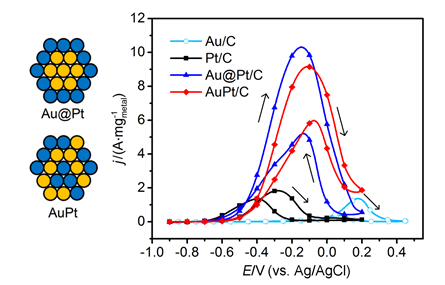| [1] Li, H. H.; Zhao, S.; Gong, M.; Cui, C. H.; He, D.; Liang, H. W.; Liang, W.; Yu, S. H. Angew. Chem., Int. Ed. 2013, 52, 7472.
[2] Coutanceau, C.; Baranton, S. WIREs Energy Environ. 2016, 5, 388.
[3] de Lucas-Consuegra, A.; Ana, R.; Calcerrada, A. B.; Linares, J. J.; Horwat, D. J. Power Sources 2016, 321, 248.
[4] Chen, H. M.; Xing, Z. L.; Zhu, S. Q.; Zhang, L. L.; Chang, Q. W.; Huang, J. L.; Cai, W. B.; Kang, N.; Zhong, C. J.; Shao, M. H. J. Power Sources 2016, 321, 264.
[5] Lamy, C.; Lima, A.; LeRhun, V.; Delime, F.; Coutanceau, C.; Leger, J. M. J. Power Sources 2002, 105, 283
[6] Rao, L.; Jiang, Y. X.; Zhang, B. W.; You, L. X. H.; Li, Z. H.; Sun, S. G. Prog. Chem. 2014, 26, 727(in Chinese). (饶路, 姜艳霞, 张斌伟, 游乐星, 李崭虹, 孙世刚, 化学进展, 2014, 26, 727.)
[7] Zheng, H. T.; Li, Y.; Chen, S.; Shen, P. K. J. Power Sources 2006, 163, 371.
[8] Wang, Y.; Zou, S.; Cai, W. B. Catalysts 2015, 5, 1507.
[9] Xu, C. W.; Cheng, L. Q.; Shen, P. K.; Liu, Y. L. Electrochem. Commun. 2007, 9, 997.
[10] Wang, Y.; Jiang, K.; Cai, W. B. Electrochim. Acta 2015, 162, 100.
[11] Adzic, R. R.; Zhang, J.; Sasaki, K.; Vukmirovic, M. B.; Shao, M.; Wang, J. X.; Nilekar, A. U.; Mavrikakis, M.; Valerio, J. A.; Uribe, F. Top. Catal. 2007, 46, 249.
[12] Mulvaney, S. P.; Keating, C. D. Anal. Chem. 2000, 72, 145.
[13] Enache, D. I.; Edwards, J. K.; Landon, P.; Solsona-Espriu, B.; Carley, A. F.; Herzing, A. A.; Watanabe, M.; Kiely, C. J.; Knight, D. W.; Hutchings, G. J. Science 2006, 311, 362.
[14] Song, H. M.; Anjum, D. H.; Sougrat, R.; Hedhili, M. N.; Khashab, N. M. J. Mater. Chem. 2012, 22, 25003.
[15] Chen, Y. G.; Zhuang, L.; Lu, J. T. Chin. J. Catal. 2007, 28, 870(in Chinese).(陈酉贵, 庄林, 陆君涛, 催化学报, 2007, 28, 870.)
[16] Li, J. F.; Yang, Z. L.; Ren, B.; Liu, G. K.; Fang, P. P.; Jiang, Y. X.; Wu, D. Y.; Tian, Z. Q. Langmuir 2006, 22, 10372.
[17] Dai, Y.; Chen, S. L. ACS Appl. Mater. 2014, 7, 823.
[18] Brankovic, S. R.; Wang, J. X.; Adzic, R. R. Surf. Sci. 2001, 474, 173.
[19] Liu, Y.; Gokcen, D.; Bertocci, U.; Moffat, T. P. Science 2012, 338, 1327.
[20] Engelbrekt, C.; Seselj, N.; Poreddy, R.; Riisager, A.; Ulstrup, J.; Zhang, J. D. J. Mater. Chem. A 2016, 4, 3278.
[21] Zhou, Y. W.; Du, C. Y.; Han, G.; Gao, Y. Z.; Yin, G. P. Electrochim. Acta 2016, 217, 203.
[22] Xu, C. X.; Wang, R. Y.; Chen, M. W.; Zhang, Y.; Ding, Y. Phys. Chem. Chem. Phys. 2010, 12, 239.
[23] Zeng, J.; Yang, J.; Lee, J. Y.; Zhou, W. J. Phys. Chem. B 2006, 110, 24606.
[24] Xu, Y. Y.; Dong, Y. N.; Shi, J.; Xu, M. L.; Zhang, Z. F.; Yang, X. K. Catal. Commun. 2011, 13, 54.
[25] Ye, W.; Kou, H.; Liu, Q.; Yan, J.; Zhou, F.; Wang, C. Int. J. Hydrogen Energ. 2012, 37, 4088.
[26] Kitchin, J. R.; Norskov, J. K.; Barteau, M. A.; Chen, J. G. Phys. Rev. Lett. 2004, 93, 156801.
[27] Demirci, U. B. J. Power Sources 2007, 173, 11.
[28] Wakisaka, M.; Mitsui, S.; Hirose, Y.; Kawashima, K.; Uchida, H.; Watanabe, M. J. Phys. Chem. B 2006, 110, 23489.
[29] Zhu, C.; Hai, Y.; Zhao, Z. G.; Yang, Y. Y. Acta Chim. Sinica 2017, 76, 30. (in Chinese) (朱婵, 海洋, 赵志刚, 阳耀月, 化学学报, 2017, 76, 30.)
[30] Zhou, W.; Lee, J. Y. Electrochem. Commun. 2007, 9, 1725.
[31] Maillard, F.; Savinova, E. R.; Stimming, U. J. Electroanal. Chem. 2007, 599, 221.
[32] Qin, Y. H.; Yang, H. H.; Zhang, X. S.; Li, P.; Zhou, X. G.; Niu, L.; Yuan, W. K. Carbon 2010, 48, 3323.
[33] Liang, Z. X.; Zhao, T. S.; Xu, J. B.; Zhu, L. D. Electrochim. Acta 2009, 54, 2203
[34] Lebedeva, N. P.; Koper, M. T. M.; Feliu, J. M.; Van Santen, R. A. J. Electroanal. Chem. 2002, 524, 242.
[35] McCallum, C.; Pletcher, D. J. Electroanal. Chem. 1976, 70, 277.
[36] Gilman, S. J. Phys. Chem. 1964, 68, 70.
[37] Suntivich, J.; Xu, Z.; Carlton, C. E.; Kim, J.; Han, B.; Lee, S. W.; Bonnet, N.; Marzari, N.; Allard, L. F.; Gasteiger, H. A.; Hamad-Schifferli, K.; Shao-Horn, Y. J. Am. Chem. Soc. 2013, 135, 7985.
[38] Chen, G. L.; Chen, S. P.; Zhen, C. H.; Zhou, Z. Y.; Sun, S. G. Acta Chim. Sinica 2001, 59, 1253(in Chinese). (陈国良, 陈声培, 甄春花, 周志有, 孙世刚, 化学学报, 2001, 59, 1253.)
[39] Bayer, D.; Berenger, S.; Joos, M.; Cremers, C.; Tübke, J. Int. J. Hydrogen Energ. 2010, 35, 12660.
[40] Teng, X. In Materials and Processes for Energy:Communicating Current Research and Technological Developments, Atrazhev, V. V.; Burlatsky, S. F., Formatex Research Center, Durham, 2013, pp. 473~484.
[41] Wang, S. Y.; Kristian, N.; Jiang, S. P.; Wang, X. Nanotechnology 2008, 20, 025605.
[42] Wang, H.; Jiang, K.; Chen, Q.; Xie, Z.; Cai, W. B. Chem. Commun. 2016, 52, 374. |
